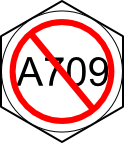Newest FAQs
Yes. 44W / 300W is the Canadian version of A36 steel, and is a grade within the CSA G40.21-04 specification. The Canadian Standards Association specification G40.21 covers structural quality steel plates, shapes, sheet, sheet piling, cold-formed channels, hollow sections, Z sections, and bars. 44W steel has slightly higher mechanical requirements than A36, which are summarized... Read more
While there is certainly nothing to preclude ASTM A193 B7 from being specified for anchor bolts – and Portland Bolt manufactures them quite often – the specification is not intended for anchor bolt use. ASTM F1554 Grade 105 is a specification specifically developed for anchor bolts and possesses virtually identical chemical and physical properties. ASTM... Read more
According to ASTM A490-11, the answer is no. The A490 specification only covers diameters from 1/2″ to 1-1/2″, inclusive. An A490 bolt cannot be made above 1-1/2″ diameter; ASTM does not allow it. Since there are no chemical requirements, hardness requirements, or strength requirements for A490 fasteners above 1-1/2″ diameter, no manufacturer would be able... Read more
The ASTM A449 specification is somewhat ambiguous when it comes to the marking requirements. While the requirements are perfectly clear for hex bolts and studs, the verbiage doesn’t address head styles other than hex head, other bolt configurations such as U-bolts, or rods with threads on each end. ASTM A449, Section 16.1, Manufacturers Identification reads as follows:... Read more
F1554 Grade 55 anchor bolts are not always weldable. The weldability of Grade 55 is a supplemental requirement referred to as “S1”, which must be specified. According to the ASTM F1554 specification under section S1.1, “This supplemental section, by chemical composition restrictions and by a carbon equivalent formula, provides assurance of weldability.” For F1554 Grade 55... Read more
lead time | Noun /ˈliːdˌtaɪm/ The time between the initiation and completion of a production process. A common question our estimators field from prospective customers is, “What is your lead time?” Before we answer this question, let’s first address the term “lead time.” The dictionary defines a lead time as the time interval between the... Read more
Yes. According to ASTM F1554-15 when Grade 36 is specified, a weldable Grade 55 may be furnished at the supplier’s option. F1554 Grade 36 vs. F1554 Grade 55 F1554 is the ASTM specification for fasteners that have an intended use for anchoring structural supports to concrete foundations. The specification is available in three strength grades:... Read more
This is a common problem, and one that can be very difficult to remedy once the concrete is cured. As with most job-site fixes, the repair method depends on the nature of the problem and when in the construction process it is first noted. The repair method may be different if one bolt is out... Read more
Portland Bolt is often faced with this question, and because there are many conflicting sources online, we decided to do a little research on our own. The resource we found most helpful was ASME B31.1-2012. In this specification, there is a table which shows the maximum allowable stress values in Tension (KSI) for metal temperature.... Read more
The simple answer here is no. ASTM A709 is a specification that covers carbon and high-strength structural steel plates and bars intended for use in bridge applications. There are multiple grades of A709 and Grade 36 covers the structural steel made from mild carbon steel, such as A36. Although Portland Bolt would manufacture an A709 Grade... Read more

